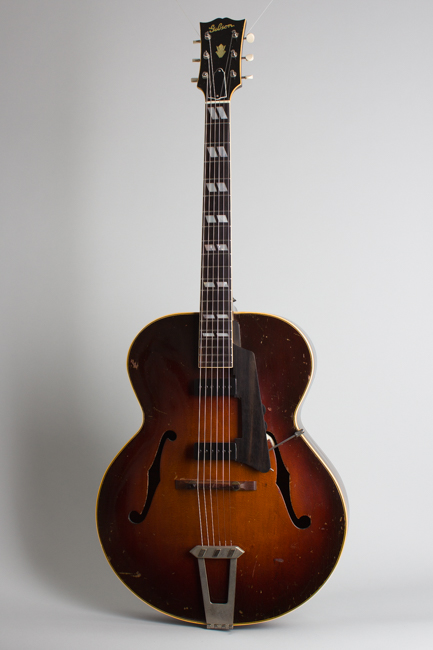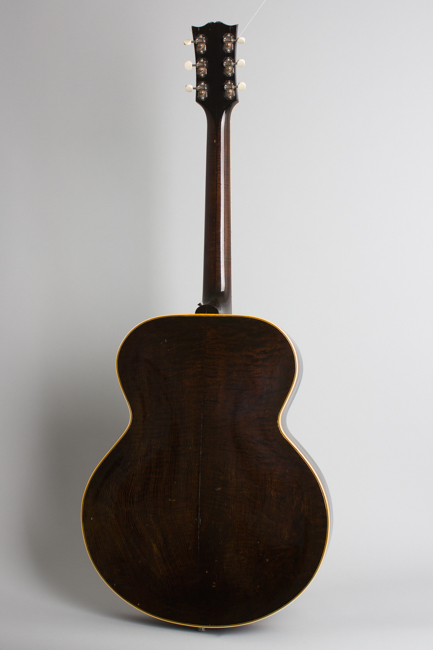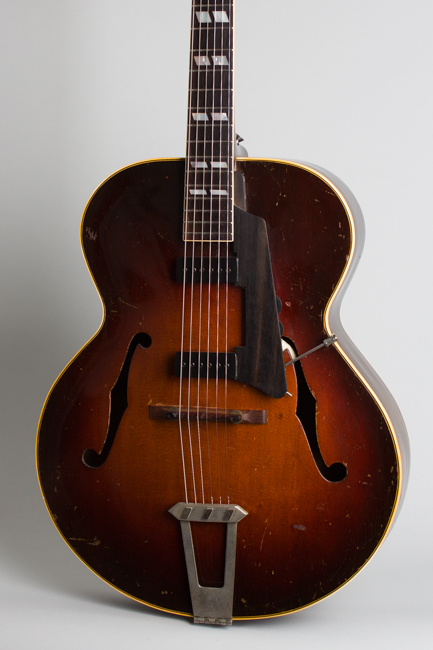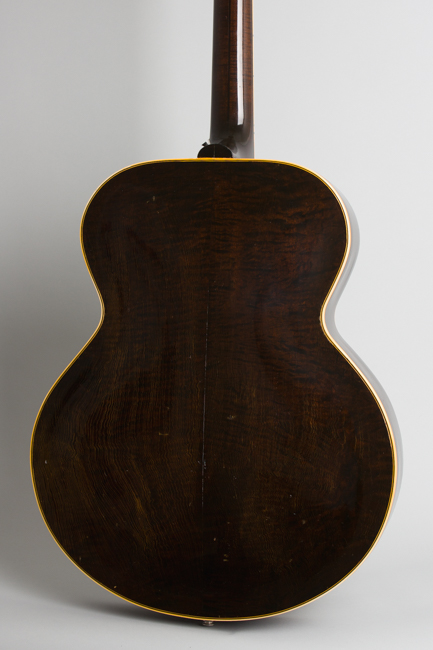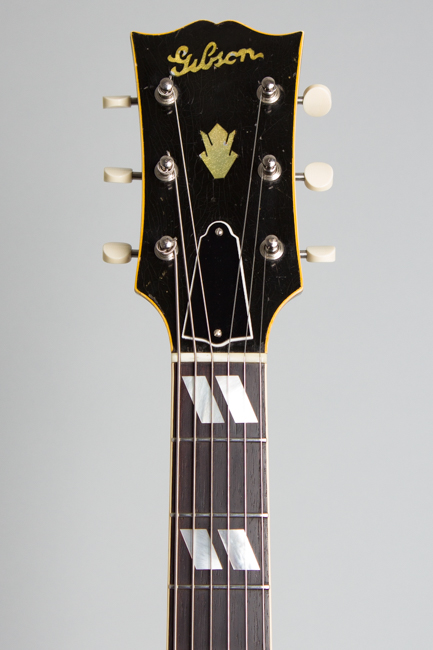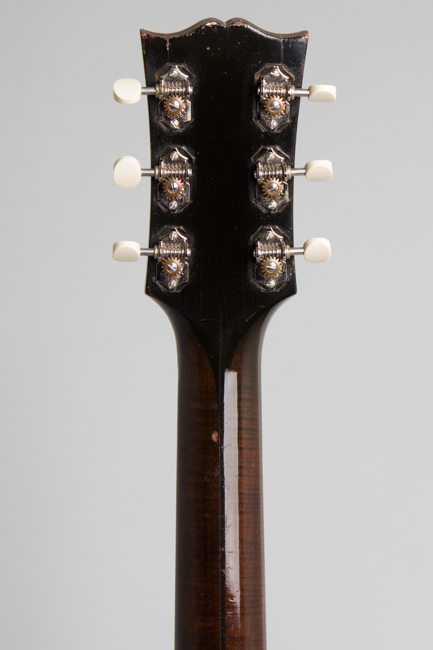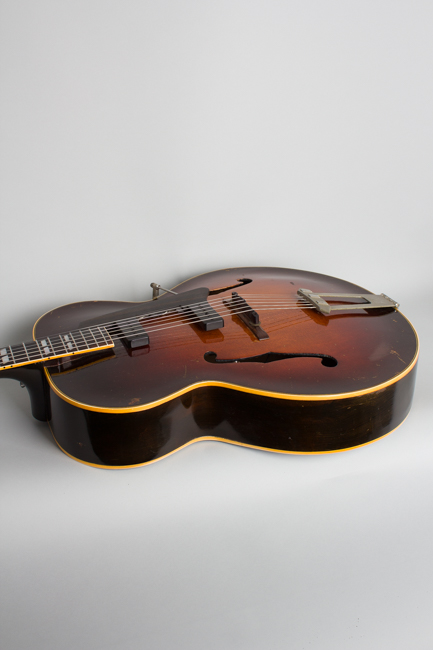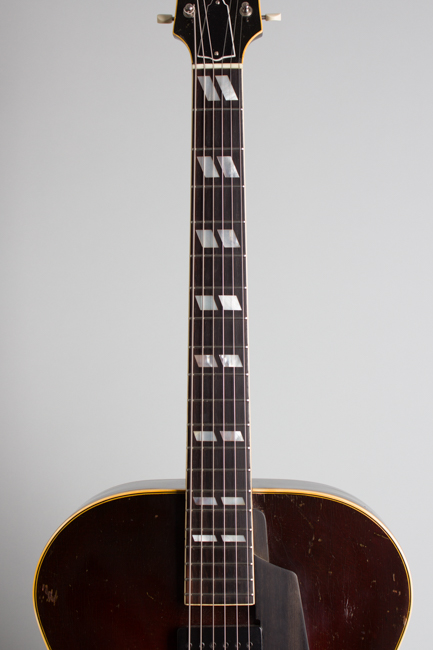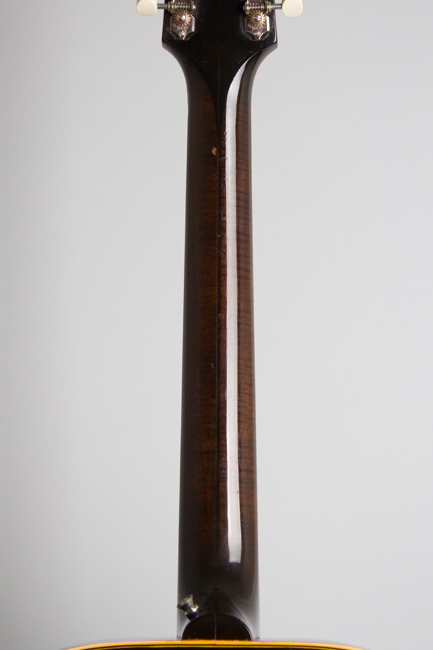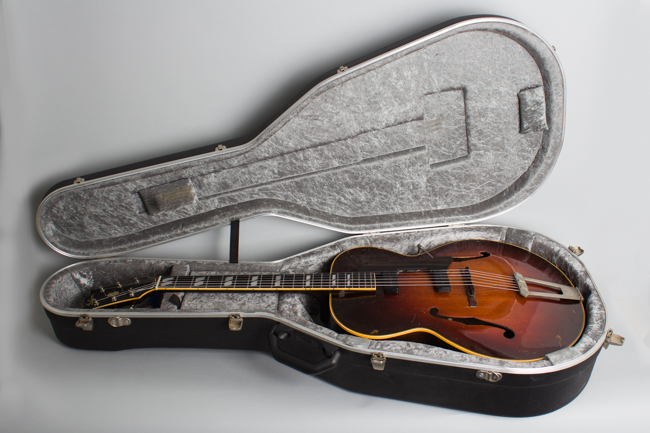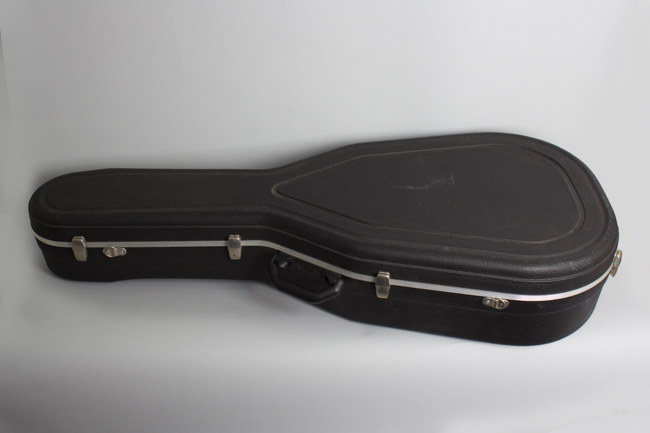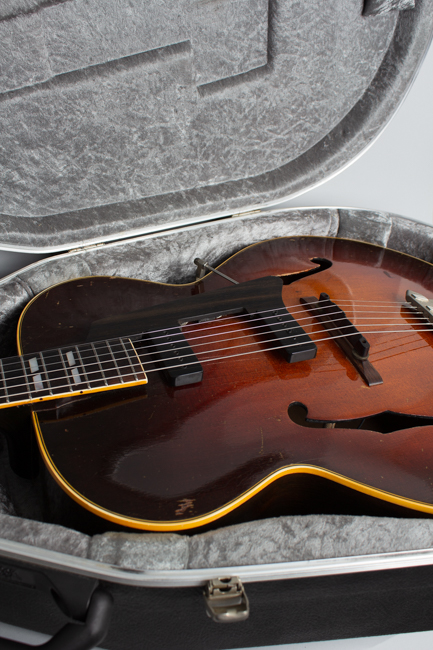Gibson L-7 Dual Floating Pickup Arch Top Acoustic Guitar (1947)
Item # 10645
Prices subject to change without notice.
Gibson L-7 Dual Floating Pickup Model Arch Top Acoustic Guitar (1947), made in Kalamazoo, Michigan, serial # A-1020, sunburst top, dark back and sides finish, maple back and sides, spruce top; laminated maple neck with rosewood fingerboard, molded plastic hard shell case.
This Gibson L-7 was made shortly after end of WWII. It was shipped out of Kalamazoo in December 1947 and has seen some adventures since including having a double floating pickup rig added but its essential character remains intact. At the time Gibson was just getting back to full time instrument production after the disruptions of the war years. The L-7 was Gibson's lowest priced professional grade 17" archtop guitar, and had already been a staple of the company's line for some years. The instrument offered the same basic qualities as the flagship L-5 at about half the cost, with most differences between the two being just decorative elements.
A feature on this instrument specific to this early postwar era is the retention of the pre-war Gibson script headstock logo, which disappeared the next year in favor of the new block script version. The sunburst top has a very dark, almost somber hue; the back and sides are finished in deep brown. The top and back have thick triple celluloid binding; the fingerboard and headstock are single-bound. The rosewood fingerboard features the double parallelogram inlay that became a post-war Gibson trademark. The neck has a fairly chunky profile, though not so thick as some wartime guitars.
The tailpiece and bridge are typical Gibson fittings. The original pickguard has been replaced by a wooden unit carrying two floating magnetic pickups and their associated controls, which are discreetly mounted under the lower edge. The signal is routed to an endpin jack mounted through the original tailpiece base. Beneath this is another endpin jack; this is connected to a contact pickup mounted un der the bridge. Either or both of these can be used alone or in stereo combination offering quite a versatile range of amplified options.
Apart from two jack holes in the end block the guitar has not been routed or modified for this installation, there is no cutting at all to the carved top. The guitar retains its full acoustic character and could be easily re0converted to an un-amplified instrument, if desired. In any of these modes it remains a wonderful player with a very versatile tone, well capable of sounding sweet both plugged and unplugged while having a substantial reserve of natural sound for pushing into swing rhythm territory.
Overall length is 42 3/8 in. (107.6 cm.), 17 in. (43.2 cm.) wide at lower bout, and 3 3/8 in. (8.6 cm.) in depth, measured at side of rim. Scale length is 25 1/2 in. (648 mm.). Width of nut is 1 3/4 in. (44 mm.).
Despite what appear to be decades of professional use this remains a lovely guitar; while there is some alteration from the original nothing tragic has been done! The finish remains original; there is checking overall and a collection of dings, dents, scrapes and scratches. These are most noticeable on the top, including several deep dings and scrapes and what looks like a small burn mark below the tailpiece. The back of the neck has several small dings by the headstock but most of the surface is surprisingly clean. Structurally the guitar is nicely preserved with no visible crack repairs or other damage, just those two added endpin jacks.
The hardware is a mixed lot, but what is no longer original could be easily restored if desired. The tailpiece is original with some corrosion to the plating and the endpin hole enlarged, the adjustable bridge remains original. The tuners are recent Waverly openbacks, the marks of the original large-plate Klusons are still visible beneath them. The truss rod cover is not in the original style but perfectly functional. The wooden bridge saddle resembles the original but is specifically set up for an unwound G string, so is a more recent piece. The base appears original. The electrified wooden pickguard and bracket are obviously more modern, but a correct repro of the celluloid original could be substituted to return the guitar to its original acoustic mode if desired.
The guitar has been neatly refretted with period-appropriate wire and the fingerboard trued; these frets show only minor subsequent wear as does the fingerboard. While seemingly a long way from its immediate postwar roots this is a very fine sounding L-7 in acoustic or amplified mode, a veteran of just about 75 years on the planet through a lot of different eras of music. It is housed in a modern molded plastic HSC. Overall Very Good + Condition.
This Gibson L-7 was made shortly after end of WWII. It was shipped out of Kalamazoo in December 1947 and has seen some adventures since including having a double floating pickup rig added but its essential character remains intact. At the time Gibson was just getting back to full time instrument production after the disruptions of the war years. The L-7 was Gibson's lowest priced professional grade 17" archtop guitar, and had already been a staple of the company's line for some years. The instrument offered the same basic qualities as the flagship L-5 at about half the cost, with most differences between the two being just decorative elements.
A feature on this instrument specific to this early postwar era is the retention of the pre-war Gibson script headstock logo, which disappeared the next year in favor of the new block script version. The sunburst top has a very dark, almost somber hue; the back and sides are finished in deep brown. The top and back have thick triple celluloid binding; the fingerboard and headstock are single-bound. The rosewood fingerboard features the double parallelogram inlay that became a post-war Gibson trademark. The neck has a fairly chunky profile, though not so thick as some wartime guitars.
The tailpiece and bridge are typical Gibson fittings. The original pickguard has been replaced by a wooden unit carrying two floating magnetic pickups and their associated controls, which are discreetly mounted under the lower edge. The signal is routed to an endpin jack mounted through the original tailpiece base. Beneath this is another endpin jack; this is connected to a contact pickup mounted un der the bridge. Either or both of these can be used alone or in stereo combination offering quite a versatile range of amplified options.
Apart from two jack holes in the end block the guitar has not been routed or modified for this installation, there is no cutting at all to the carved top. The guitar retains its full acoustic character and could be easily re0converted to an un-amplified instrument, if desired. In any of these modes it remains a wonderful player with a very versatile tone, well capable of sounding sweet both plugged and unplugged while having a substantial reserve of natural sound for pushing into swing rhythm territory.
Overall length is 42 3/8 in. (107.6 cm.), 17 in. (43.2 cm.) wide at lower bout, and 3 3/8 in. (8.6 cm.) in depth, measured at side of rim. Scale length is 25 1/2 in. (648 mm.). Width of nut is 1 3/4 in. (44 mm.).
Despite what appear to be decades of professional use this remains a lovely guitar; while there is some alteration from the original nothing tragic has been done! The finish remains original; there is checking overall and a collection of dings, dents, scrapes and scratches. These are most noticeable on the top, including several deep dings and scrapes and what looks like a small burn mark below the tailpiece. The back of the neck has several small dings by the headstock but most of the surface is surprisingly clean. Structurally the guitar is nicely preserved with no visible crack repairs or other damage, just those two added endpin jacks.
The hardware is a mixed lot, but what is no longer original could be easily restored if desired. The tailpiece is original with some corrosion to the plating and the endpin hole enlarged, the adjustable bridge remains original. The tuners are recent Waverly openbacks, the marks of the original large-plate Klusons are still visible beneath them. The truss rod cover is not in the original style but perfectly functional. The wooden bridge saddle resembles the original but is specifically set up for an unwound G string, so is a more recent piece. The base appears original. The electrified wooden pickguard and bracket are obviously more modern, but a correct repro of the celluloid original could be substituted to return the guitar to its original acoustic mode if desired.
The guitar has been neatly refretted with period-appropriate wire and the fingerboard trued; these frets show only minor subsequent wear as does the fingerboard. While seemingly a long way from its immediate postwar roots this is a very fine sounding L-7 in acoustic or amplified mode, a veteran of just about 75 years on the planet through a lot of different eras of music. It is housed in a modern molded plastic HSC. Overall Very Good + Condition.
